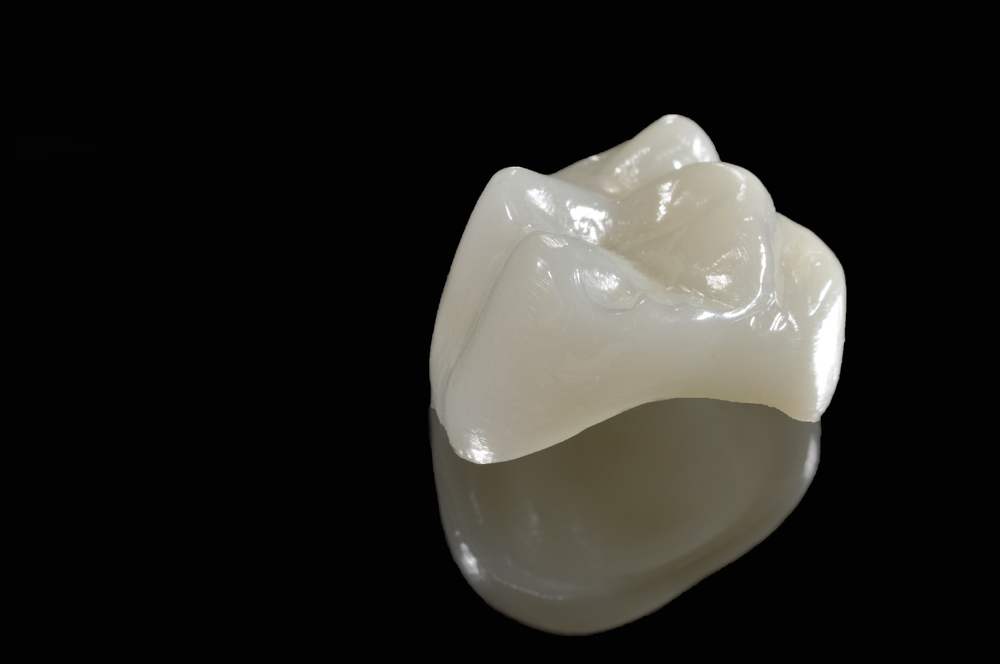DENTAL CROWNS
WHAT IS A DENTAL CROWN
A dental crown is a restorative filling for a tooth, which as the name suggests, sits on top of the damaged tooth right to the gum line. Apart from strengthening a damaged tooth, the crown can be used to improve its appearance, shape or alignment. Dental Crowns are also used on implants to provide a tooth- like shape and structure.
WHEN IS A DENTAL CROWN NEEDED
There are many situations that require a tooth to be restored with a DENTAL CROWN. The most common are:
LARGE FILLING
When a tooth has a large hole or fracture that involves half the width of the tooth or more, it needs to be covered with a CROWN. In this case the crown is required as the remaining tooth around the large filling is so weak that it is prone to fracture. Similarly a large filling that has been in the mouth for a while will need to be replaced with a crown because the tooth shows signs of stress and cracks around the filling. If left untreated symptoms may develop where a root canal is required
ROOT CANAL TREATMENT
Root canal treatment leaves the tooth hollowed out and predisposes the remaining tooth to cracking. Therefore a tooth that has had a root canal almost always needs to be restored with a crown immediately after the treatment to prevent it from fracturing.
CRACKED TOOTH SYNDROME
This is a condition where a patient has fractures inside a tooth that causes pain when it is chewed on a certain way. Chewing produces stress on fracture lines that make it feel like it is splitting apart and sends a shooting pain signal. A crown will hold the tooth together and redistribute the stress evenly throughout the tooth. In most instances , stopping the pain. In cases like this it is common to leave a temporary crown on for a while to make sure the pain goes away and the tooth doesn't require a root canal.
BROKEN CUSPS
Cusps are the pointy parts of the teeth and can frequently break off due to trauma or large existing fillings. Since the cusps are the part of the tooth that take the most stress during chewing, they need to be completely covered or the tooth will keep fracturing. Sometimes the tooth will break all the way to the bone. Therefore a crown-lengthening procedure is necessary. This procedure involves trimming the bone and gums down below the edge of the fractured part of the tooth. This allows the crown to be placed on a healthy, strong tooth structure for support.
EXCESSIVE WEAR
If a person has a habit of grinding, their teeth will become shorter over time. Teeth can also wear away due to acid erosion. This can be due to gastrointestinal acid reflux (GERD), Bulimia, excessive vomiting during pregnancy or an acidic diet. Sometimes, the enamel can wear away completely, leaving small, soft teeth. In extreme cases the bite can collapse after a period of time. When this happens covering the teeth with crowns to increase the patients bite is the only way of restoring the teeth properly.
DENTAL IMPLANTS
Crowns are placed on dental implants to restore spaces left from missing teeth. Another way of filling these spaces is with dental bridges, which are made from crowns on the teeth next to the spaces attached to the constructed teeth in the middle. If teeth are loose, crowns can be placed on multiple teeth and splinted together to provide more stability.
TYPES OF CROWNS
DENTAL CROWNS CAN BE MADE FROM MANY MATERIALS. ALL OF WHICH HAVE DIFFERENT FUNCTIONS.
- Gold alloy
- Metal alloy
- Stainless steel
- Porcelain/Ceramic
- Composite resin
- Zirconia
- Porcelain on the outside fused to metal or zirconia on the inside.
There are varying uses to the different types of dental crowns. Stainless steel crowns are preformed crowns used to cover baby teeth for children. Gold dental crowns have traditionally been the most durable. Because of the strength of the material, they require less of the tooth to be removed or shaved down.
The primary advantage of porcelain – tooth coloured crowns is their aesthetics. This material looks like and is shade matched to other teeth. In addition to this , due to the advancement of technology, the ceramic or porcelain materials are more durable. Therefore this is becoming the more preferred method for a crown.
WHAT IS THE PROCEDURE FOR GETTING A DENTAL CROWN?
The area around the tooth will be "numbed" with local anesthetic to begin with. If the tooth has been fractured or had a root canal treatment, it will first need to have a build up filling. This is required to restore enough of the tooth for the crown to hold onto. The tooth is then shaved down to make room for the crown. An impression is made of the prepared tooth. If it is to be sent to the Lab, this will be done physically with a putty like substance. If it is a CEREC crown the impression will be done digitally with the scanner.
The Dentist will then determine the shade match using a shade guide. Then either of the following will apply;
LAB MADE CROWN
Pictures may be taken to send off with the shade match when the crown is to be sent to the lab. This will help the technician make the crown to match the rest of the patient’s teeth. A temporary crown is then cemented with temporary cement so that it can be removed easily once the permanent crown is ready.
Approximately 3 weeks later, the patient returns for a second visit. During this visit the tooth may need to be numbed and the temporary crown is removed. The permanent crown is placed on the tooth and inspected for an acceptable fit. After the necessary adjustments are made, the crown will be cemented with a permanent cement or dental glue.
CEREC MADE CROWN
If the crown is a CEREC crown made at Vermont South Dental, it will be milled from a ceramic block using the CEREC machine. It will be tested in place to ensure the bite is good and that it fits well. Then you get to relax with a half hour break. During this time the crown is cooked to finalise the strengthening properties of the material. Once completed any necessary adjustments will be made and then the crown is permanently cemented in place.
ONE DAY - SAME VISIT CROWNS
CEREC CROWNS -SAVE TIME & MONEY
This type of crown is made right here at Vermont South Dental . The Crown is milled from a block of porcelain with our CEREC machine using CAD/CAM technology.
THE WHOLE PROCESS CAN BE DONE IN ONE MORNING APPOINTMENT
Therefore ;
- A temporary crown is not needed
- The dental lab is not required
- A follow up appointment is not needed.
FREQUENTLY ASKED QUESTIONS
WHAT KIND OF PROBLEMS CAN OCCUR AFTER GETTING A DENTAL CROWN?
Crown preparation can sometimes place a lot of stress on a tooth. Especially if the tooth has had previous ongoing problems and trauma. This can cause the nerve to become irreversibly inflamed. All though this is rare, if this happens, the tooth may require root canal treatment.
HOW MUCH DO CROWNS COST?
The cost of getting a crown can vary. The type of material used will depend on the location and the purpose of the tooth. Therefore a crown or veneer can cost anywhere between $600 - $2,000. Health Insurances can cover part of the cost but the rebate varies with individual plan's and each insurer. You will be given a detailed treatment plan upon diagnosis, which will indicate the cost. You can then contact your health fund provider and ask then exactly what you will receive back.
HOW LONG DO CROWNS LAST?
Dental crowns should last on average from 10 to 20 years.
DENTAL CROWNS ARE STILL SUBJECT
TO FRACTURE AND CAVITIES.
Because of this it is important to take extra care with brushing and flossing around crowned teeth and eating a healthy balanced diet to prevent them from needing replacement more often.



